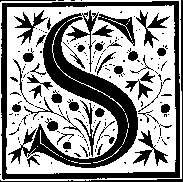Skåne

Just the other day, for example, I joined a group of academics and University visitors at a dinner party. While we were standing around at the start, I fell into conversation with a charming young woman who asked me something I didn't quite follow. Earthling, I replied, quick as a wink, I come from the depth of Sub-Space to conquer your world! She smiled vaguely at me, and I later discovered that she was Lithuanian, and knew even less Swedish than I did.
A few minutes later, our hostess began to distribute us into seats around the table in the garden. This time, I knew that she was speaking Swedish, and so I nodded and said: If Doom has done what I fear, then the entire Universe is in danger! She assigned me a position at the corner of the garden, behind a tree.
I might have felt left out, except that much of the evening was taken up with a series of toasts in a clear liquid which I have not experienced before. After the last toast that I can remember, I think I said Aaaargh, I am slipping back into the Negative Zone. Then again, I may have said something else entirely. By that point, to tell the truth, there were not many phrases of Marvel Comics Swedish left in my repertoire. However, after I had poured myself into a bus to return to my rented flat, I was just able to greet the bus-driver with Aha, everything goes exactly according to my plan! Fortunately, the bus-stop for my flat is the end of the line.
 hen not pursuing this line of study, I have been learning what I can about this part of Sweden. The main towns of Skåne are Lund, where I am living, and the nearby seaport of Malmö. Lund is the older settlement, founded in 1020 by King Canute. A couple of hundred years later, the Danes built the cathedral or Domkyrkan here. It was an expensive operation, and before long the Danish monarchy found itself so pressed for cash that it sold off the whole of Skåne to King Magnus the Mildewed of
Sweden for a few hundred-weight of salted herring. An interminable legal wrangle followed, which ended only when the Swedes gave back the herring, and the Danes repossessed Skåne.
hen not pursuing this line of study, I have been learning what I can about this part of Sweden. The main towns of Skåne are Lund, where I am living, and the nearby seaport of Malmö. Lund is the older settlement, founded in 1020 by King Canute. A couple of hundred years later, the Danes built the cathedral or Domkyrkan here. It was an expensive operation, and before long the Danish monarchy found itself so pressed for cash that it sold off the whole of Skåne to King Magnus the Mildewed of
Sweden for a few hundred-weight of salted herring. An interminable legal wrangle followed, which ended only when the Swedes gave back the herring, and the Danes repossessed Skåne.
After that, there was the Union of Kalmar, in which Denmark and Sweden merged, followed by the inevitable messy divorce which went on for 200 years, and then in rapid succession the Black Death, the Northern War, the Reformation, and the invention of aquavit.
Next, the engineers of king Gustav Adolf the Addled invented fearsome new military techniques, such as mobile artillery which fired a devastating sauce made of fermented herring. With these weapons, Sweden became the major imperial power of The North in the 17th Century, and even conquered Livonia and Pomerania. (Both of these places no longer exist, you will observe, but if they did they would harbor fond memories of "the good old Swedish times," or so people here believe.)
Soon after, Sweden scored a famous victory over its traditional enemy Denmark. The Swedish king Karl the Clammy achieved the element of surprise by bringing his army to the backside of Copenhagen by bus --- nobody had noticed when a travel agent in Stockholm purchased 30,000 round-trip tickets --- and laid siege to the capital. The Danes hurriedly capitulated, so that the trouble would be over before the next tour-group arrived, and ceded Skåne back to Sweden again.
The Skånians, by this time thoroughly confused, responded by putting the Social Democrats in charge of Malmö, where they have remained in charge ever since. Opponents regularly attack the Social Democrats as still being in the middle ages, and there is some truth in this. At the big May Day parade in Malmö, I noticed that all the people carrying Social Democrat banners were middle-aged, if not older. They were undoubtedly SD party stalwarts of long standing, and probably had fond personal memories of the 17th Century.
The parade took half an hour to pass through Gustav Adolfs Torget, a relaxed, good-humoured crowd of working people of all ages. They strolled along in between more formal elements, namely marching bands and flag-bearers who apparently represented different shops or unions. Every so often, there was a pair of mounted police riding huge, handsome horses. Prime minister Goran Persson, who hails from Malmö, joined the festivities, I am told --- although I didn't recognize him specifically among the marchers. So in Malmö, as the parade demonstrated, unions and the Social Democrats are part of the establishment. This of course strikes an American as like something from another planet, pure science-fiction.
Social Democracy in this part of the world has roots not only in the workers' movement, but in the coöperative movement and in an old-fashioned, communitarian ethos of the whole nation as a family. It was summed up by the Social Democrats of the last generation, and the one before that, in the word folkhemmet, meaning "the people's home." "In the people's home," the SD leader Per Albin Hanson used to say in the 20s and 30s, "there are neither favorites nor step-children." This conception of society led to a high standard of public provision, under governments dominated by the Social Democrats for most of the last three generations.
I have long felt rather moved by the idea of "the people's home," coming as I do from a place where thousands of step-children sleep in the streets, and in which social "dynamism" is conventionally defined in terms of a wealth differential of a million-fold, or better yet a billion-fold, between favorites and step-children. Proponents of this system --- which one might name Banana Republicanism --- claim that it fosters creativity. Sure enough, the USA has indeed created products that northern Europe never even imagined, such as Coca-Cola, the sports utility vehicle, the barca-lounger, Microsoft Windows, and George W. Bush. I guess it's a question of how you define "dynamism" or "creativity."
 hortly after king Karl the Clammy took back Skåne from the Danes in
1658, he shrewdly established a university in the old, Cathedral town of
Lund. This provided the Swedish monarchy with a site for the teaching of
Latin, Rhetoric, Entrepreneurship, and Feminist Cultural Theory, as well
as an incubator for public/private partnerships in cutting edge
technology. Since universities were also rumoured to contain
undergraduate students, the administration set up frat houses, called
nationer, each of which was equipped with its own bar. Ever
since, Lund has been filled with a mob of undergraduates who have spent
the last 330 years singing, shouting, screaming, slamming car doors,
throwing furniture --- and sometimes each other --- out of windows.
hortly after king Karl the Clammy took back Skåne from the Danes in
1658, he shrewdly established a university in the old, Cathedral town of
Lund. This provided the Swedish monarchy with a site for the teaching of
Latin, Rhetoric, Entrepreneurship, and Feminist Cultural Theory, as well
as an incubator for public/private partnerships in cutting edge
technology. Since universities were also rumoured to contain
undergraduate students, the administration set up frat houses, called
nationer, each of which was equipped with its own bar. Ever
since, Lund has been filled with a mob of undergraduates who have spent
the last 330 years singing, shouting, screaming, slamming car doors,
throwing furniture --- and sometimes each other --- out of windows.
I have been fortunate to be able to study these academic rituals at first hand, as they often take place directly outside my apartment at 2 AM. And, whenever I feel homesick for loud American rock music, I need only open a window, especially on weekends, to assuage the longing. Another student ritual I noticed just the other night was an impromptu concert by performers playing bongo drums and an instrument that sounded like the Australian didgeridoo. So, Skåne is certainly as plugged into the globalized, multi-cultural world as, say, Fort Lauderdale at spring break.
The hullabaloo finally dies down just before sunrise, after which I am able to get a few hours of fitful sleep, shielding myself from the sunlight by putting a paper bag over my head. By mid-morning, the streets of my neighborhood are completely empty of life, the revelry of the evening faded to a slight headache. I suppose the scholars are all off at their classes, or perhaps have adjourned to the public parks where they are holding outdoor symposia while flattening empty beer cans and scattering them amongst the shrubbery.
At this point, I can gulp down breakfast in peace, and begin the day with my botanical chores. My rented flat is full of carnivorous plants, which I avoid as much as possible but which I am responsible for watering. There are also a few plastic, artificial plants, and the landlady has helpfully left signs on them reading: "this is an artificial plant; do not water." These careful instructions are perhaps meant for her usual tenants, scholars at the University of Lund, whose minds are no doubt abstracted by deep questions of Latin, Rhetoric, or Post-Modernist Deconstruction. In a like vein, she left a sign on one chair near the balcony door which reads: "do not throw this chair out the window." Dazed by lack of sleep, I normally shamble about the living room, impartially drowning the live plants, the plastic plants, the signs, the chairs, and everything else with the contents of an antique watering can, and then fall into a reverie.
By late morning, my reverie is ended by a new sound: a maddening, intermittent tap-tap-tapping from the apartment below. It goes on for hours, with unpredictable pauses. I assume the residents downstairs are a family of elves (or tomtar in Swedish) who are just going about their normal business, cunningly fashioning their little magic shoes. Or perhaps the Swedes, at the forefront of humane penology, keep prisoners on home detention in my apartment complex, and some of the prisoners are signalling to one another, like the Count of Monte Christo. I have tried tapping messages back to the Count, but, lacking knowledge of the code, I can never understand his replies, if that is what the sounds are. Eventually, the noise drives me out to the University, or to savour the cultural delights of Lund.
These clearly surpass in excitement those of Lynd, Minnesota, Lundy, Devonshire, or Bend, Oregon --- at least taken one at a time. One can visit the local parks, and observe the duckpond. One can take a municipal bus to town center, and, once there, one can take a municipal bus back. One can visit a historical museum in which Swedish peasant hovels from previous centuries have been carefully reconstructed, revealing why so many of their inhabitants set out for the bogs of Minnesota --- perhaps, who knows? --- to found the bustling town of Lynd. In the early afternoon, one can join tout Lund in one of the city squares, where everybody sits watching everybody else. Here, I have noticed that the real natives --- those, in other words, past college age --- have an oddly stiff, mechanical gait. It took me a while to discover the explanation.
By mid-afternoon, one can go on to Lund's most striking ornament, a cultural attraction which draws tourists from as far as three kilometers away. This is the medieval clock in the Cathedral, which strikes the hour every day at 3:00 in the afternoon. Right on the hour, organ sounds of an old hymn fill the Cathedral, while wooden figures of two musicians on each side of the clock-face bring carved trumpets to their lips. Alas, the mechanism has become a little worn over the centuries, and one of the musicians brings his trumpet to his nose, while the other jams the trumpet in his left eye. Then, as the hymn wanders into the whole-tone scale, a group of carved medieval figures --- the Knight, the Pilgrim, the Almoner, the Wife of Bath, the Feminist Theorist, and the Travel Agent --- emerge from a door on one side of the clock, and lurch erratically around the clock-face, eventually tumbling into a door on the other side.
Watching them, I understood the stiff gait of the human inhabitants of Lund I have observed in the town square. It is simply the result of long residence here. The carved figures who live in the clock have been here for 700 years, and naturally suffer the most severe condition. As for me, I don't plan to let Lund enter my joints. In a few weeks, I am going to visit the elves in the apartment downstairs, buy a pair of their magic shoes, and fly away.